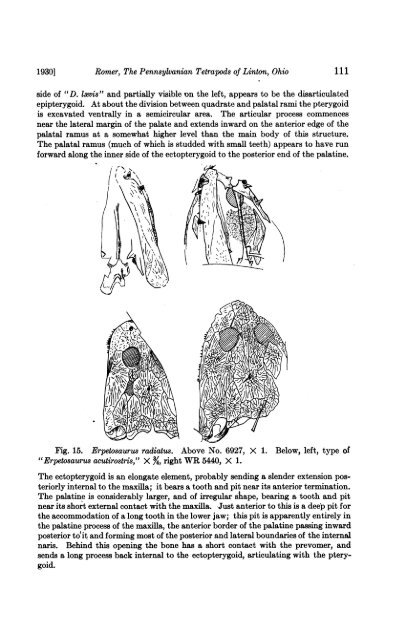View/Open - American Museum of Natural History
View/Open - American Museum of Natural History
View/Open - American Museum of Natural History
You also want an ePaper? Increase the reach of your titles
YUMPU automatically turns print PDFs into web optimized ePapers that Google loves.
19301 Romer, The Pennsylvanian Tetrapods <strong>of</strong> Linton, Ohio<br />
ill<br />
side <strong>of</strong> "D. lawis" and partially visible on the left, appears to be the disarticulated<br />
epipterygoid. At about the division between quadrate and palatal rami the pterygoid<br />
is excavated ventrally in a semicircular area. The articular process commences<br />
near the lateral margin <strong>of</strong> the palate and extends inward on the anterior edge <strong>of</strong> the<br />
palatal ramus at a somewhat higher level than the main body <strong>of</strong> this structure.<br />
The palatal ramus (much <strong>of</strong> which is studded with small teeth) appears to have run<br />
forward along the inner side <strong>of</strong> the ectopterygoid to the posterior end <strong>of</strong> the palatine.<br />
Fig. 15. Erpetosaurus radiatus. Above No. 6927, X 1. Below, left, type <strong>of</strong><br />
"Erpetosaurus acutirostris," X 4, right WR 5440, X 1.<br />
The ectopterygoid is an elongate element, probably sending a slender extension posteriorly<br />
internal to the maxilla; it bears a tooth and pit near its anterior termination.<br />
The palatine is considerably larger, and <strong>of</strong> irregular shape, bearing a tooth and pit<br />
near its short external contact with the maxilla. Just anterior to this is a deep pit for<br />
the accommodation <strong>of</strong> a long tooth in the lower jaw; this pit is apparently entirely in<br />
the palatine process <strong>of</strong> the maxilla, the anterior border <strong>of</strong> the palatine passing inward<br />
posterior to'it and forming most <strong>of</strong> the posterior and lateral boundaries <strong>of</strong> the internal<br />
naris. Behind this opening the bone has a short contact with the prevomer, and<br />
sends a long process back internal to the ectopterygoid, articulating with the pterygoid.
















